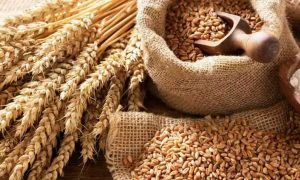Despite rain loss, wheat yield set to cross 160 lakh tonnes, says Agri dept

The total wheat yield in Punjab is expected to cross 160 lakh tonnes in the current rabi season. The state agriculture department has pegged production based on crop-cutting experiments.
The total wheat yield in Punjab is expected to cross 160 lakh tonnes in the current rabi season. The state agriculture department has pegged production based on crop-cutting experiments.
It is less than the earlier production estimates of a bumper crop when the yield was predicted to cross 175 lakh tonnes before the rainfall, high-velocity winds and hailstorm that began on March 25 and continued till April 5. The yield is expected to fall by 15 lakh tonnes, a loss of 8%. Last year wheat crop suffered a yield loss of 15% due to a sudden rise in temperatures in March when the crop was at the maturing stage.
The state food and civil supplies department, conducting the procurement of wheat, has also set a target of a total wheat purchase of 115-120 lakh tonnes. Originally, the food department made arrangements for procuring 132 lakh tonnes of wheat.
“Despite the vagaries of weather leading to flattening of the crop in over 40% of the total area, the crop has recovered, and yield is reasonably good this time with an average yield of 4,724 kilograms per hectare,” said Gurvinder Singh, director agriculture. This season wheat was cultivated over 34.9 lakh tonnes.
A complete report of all the 2,000 crop-cutting experiments is expected in the upcoming week to give a clear picture of the wheat yield, he said.
VTS system delays lifting
The vehicle tracking system (VTS), which the state food and civil supplies department is installing to track the movement of wheat from the mandis to storage points or the railheads is leading to a delay in the lifting of the purchased crop from the mandis. The slow pace of lifting has led to a glut of freshly harvested crop in the mandis.
Out of 73.07 lakh tonnes of crop purchased in the mandis, only 23.72 lakh tonnes have been lifted to date. This has left around two-thirds of the purchased crop in the mandis. Districts Tarn Taran and Amritsar lead the figures with 96% and 92% of the purchased crop waiting to be lifted, respectively. Ferozepur follows the two districts with 84% of the purchased crop waiting to be cleared from the mandis.
On Sunday, 6.87 lakh tonnes of crop arrived in the mandis of the state, taking the total arrivals to date to 75.32 lakh tonnes. According to officials of the state agriculture department, so far the harvest has been completed in over 60% of the cultivated area. A minimum support price of ₹2,125 is being offered to the farmers despite a value cut imposed by the Centre. The state government has decided to own the value cut imposed and the farmers are being made the full payment.
61 cases of stubble burning in Punjab
Since the start of the wheat harvest, 61 cases of stubble burning have been reported in the state. Eight cases each have been reported in Bathinda and Gurdaspur, six in Patiala, five in Sangrur and four each in Amritsar, Faridkot and Jalandhar.
Fatehgarh Sahib, Moga, Ropar, Mohali and Malerkotla districts have reported no cases of crop residue burning in the current harvest season. The state remote sensing centre, Ludhiana, records the burning cases on behalf of the Punjab Pollution Control Board (PPCB).
“The cases are expected to rise as the harvest is heading towards the conclusion,” said an officer in the PPCB on the condition of anonymity. According to a trend, the cases of stubble burning are much higher in paddy harvest than in the wheat-cutting season.
Food at our home was always tasty and mostly simple fare, even for parties, the spread would be prepared by my mother who was a fauji wife and had a treasure of recipes, thanks to ladies’ clubs from the various stations my dad had served at. But anytime there was something big, an anniversary, birthday or the last day before we were shipped off to boarding school after the holidays, the treat at our dinner table would always be ordered-in butter chicken with naan.
When we would be visiting my paternal grandparents, there was this one place that became our go-to for our packed dinner, so much so, the gentleman who used to take our order could soon pre-empt our requirement. It was not a fancy place, but the preparation was outstanding and, in those days, it suited my father’s pocket.














